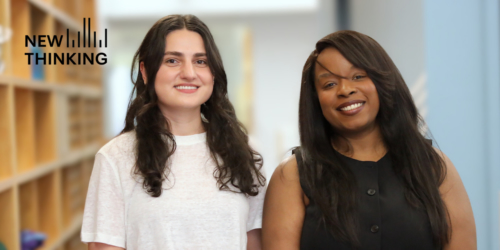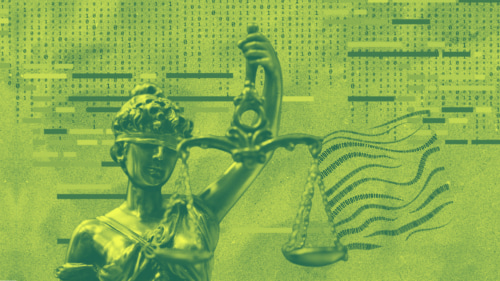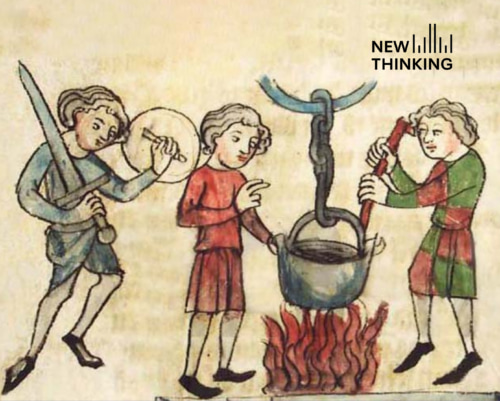Ange Hwang, executive director of Asian Media Access, and Tyree Lawrence, executive director of the community-based LVY Foundation, joined this week’s podcast to discuss the philosophy behind Stand Up Participate’s curriculum, which includes audio/visual technology training, culturally based family engagement programming, health education, and organized activities with police and community members that seek to improve communication and mutual understanding.
The following is a transcript:
RAPHAEL POPE-SUSSMAN: Hi. This is Raphael Pope-Sussman of the Center for Court Innovation. This podcast is part of the series we are doing with people seeking to curb violence and improve access to public health for at-risk minority youth as part of the Minority Youth Violence Prevention Initiative. The Initiative is a partnership of the Office of Minority Health at the US Department of Health and Human Services and the Office of Community Oriented Policing Services at the US Department of Justice that encourages collaboration among public health organizations, law enforcement agencies, and community-based groups.
Our podcast series highlights innovative approaches at the 9 demonstration sites that have received funding under the program. This week, we’re looking at the Stand Up, Participate Program in Hennepin County Minnesota. Stand Up, Participate is an initiative led by the community-based organization, Asian in Media Access in partnership with local public health and law enforcement agencies as well as other community-based groups like the LVY Foundation. Stand Up, Participate seeks to prevent youth violence by helping young people acquire skills for self-sufficiency, improve self-esteem, and develop cultural pride.
I’m speaking today with Ange Hwang, executive director of Asian Media Access, and Tyree Lawrence, executive director of the LVY Foundation. Ange, Tyree, thank you for speaking with me today and welcome.
HWANG: Thank you.
LAWRENCE: Thank you.
POPE-SUSSMAN: For starters, can you describe Stand Up, Participate?
HWANG: Sure. This is Ange from Asian Media Access. Stand Up, Participate has been focusing to use bi-cultural healthy living as a concept to encourage particularly Asian American community and African American community so we will hope is by working through cultural pride and really giving you there a control sometimes. Sometimes that will be something they’d be proud of so they will be more willing to participate and to change their behaviors. So they would decrease the at-risk behaviors and really be able to participate back to the communities.
We are doing that through couple different venues. In Asian Media Access focusing on multimedia training so the youth will build on self-esteem. We focusing on the cultural classes such as Asian dances so the youth can be able to regain the culture pride. Tyree will do a little bit different than us and I will have him to talk a little bit more.
LAWRENCE: Yes, our part of the Stand Up and Participate movement really focuses on entrepreneurship and economic development. A lot of the young men, the African American young men in particular, are often challenged with some of the caveats they face in society and certain stigmas, if you will. We leverage the ability for them to tap into their own personal potential and their talents and then take it to another level by allowing them to explore those talents in a way that ends up in a form of business or some type of trade or skill set so that they can really find alternatives to whatever lifestyle may be prohibiting them from just living life in general and just being, quote unquote, normal.
HWANG: Yeah. I think Tyree’s strategy is touching a very important part is to really giving youth a choice, giving them a power to choose some of the skills they like to acquire such as entrepreneurship and such as multimedia. After they do that, they’re really building their own team to get away from other negative influence around them to really be able to focus and really starting to become a contributing citizen. Then we bring in our partners, particularly at the public health and the police departments, to providing such as mentorship such as talking about how we can improve relationship together with the police department and also having them to even just take them to shop. We have one activity, back to school shopping with the cops. The cops pick up 30 at-risk youth and then we got Target Foundation to support. Each youth has $100 spending money so the cop guide them through Target to purchase all the school equipment. By doing this type of activity and empower the youth to have a choices and power and control, they feel they can choose a better route for themself. I feel this strategy is very effective.
POPE-SUSSMAN: How is funding from the Minority Youth Violence Prevention Initiative enable Stand Up, Participate to work with its target population and expand services?
HWANG: The funding for us has been so helpful particularly being able to do a lot of trainings and recruiting support groups with this youth and we can do a lot of creative and innovative outreach. I would like to particularly emphasizing that by culture healthy living, we have been utilizing, as a central theme, for all the activities particularly, for example, our Asian youth. We try to encourage them to exercise more, so Asian dances and martial arts. That’s really tied them back to their culture roots. We really attract more youth to the program with this type of activity instead of trying to utilizing mainstream activities. We design the project with that bi-cultural activity in mind. That would help more and more of those at-risk youth of color would be willing to come into the program because it’s coming from their culture and it’s built on their strengths. This funding source is so important. Tyree, want to add more?
LAWRENCE: Definitely. We will also parallel. It’s a huge mechanism that’s been able to help us as far as promoting the abilities and the talents of these individuals who may not, otherwise, be on a platform. For instance, being able to get in front of a corporation like 3M and show the many attributes that parallel what they’re currently teaching their employees has been phenomenal. We wouldn’t have been able to develop this type of platform had it not been for the funding.
HWANG: Yeah. I think, particularly I would really want to piggy back what Tyree had said. If not had the funding, we won’t be able to develop. I think this is really the key because a lot of times we see a lot of funding, maybe supporting a police academy and police academy to outreach to other youth and then recruit. But we do actually opposite way. We starting with the community. We have the community build that support group. Then outreach back to the police, back to the public health in seeking for support, seeking for training, and seeking to improve that relationship.
POPE-SUSSMAN: How have the youth been responding to the programming so far?
LAWRENCE: The youth have been actually responding quite positively to what we’re trying to do as far as encouraging a more self-initiated healthier lifestyle. We’re taking strife in the youth group that I deal with and are they ready to sit down across from police officers and have these wholehearted discussions? I would say we haven’t reached that point just yet but what they are open to are more creative and innovative ways of having their side be understood, per se, by police officers so that there can be a more creative dialogue and hopefully we progress to something like that in the near future. Our attempts have been, I don’t want to say difficult, but not as easy as I had anticipated when starting this project.
HWANG: But that is exactly we need to hear, Tyree, because we are dealing with at-risk youth who has a distrust to the police. We having this baggage in our community for a long time and if not coming from the community, sometimes it’s very hard for this group of at-risk youth to be able to accept this type of activities. Why bother to communicate with the police? We are doing just fine. So that’s a lot of that type of thinking coming from our youth. That’s why we doing this from community perspective that the community feel the police really want to reach out. They really would like to build that bridge between both.
POPE-SUSSMAN: How are you measuring outcomes?
HWANG: We have a very dedicated evaluator working with us from the University of Minnesota has been helping us to do two major data collecting efforts. One is doing the youth survey, pre- and post-. We really focusing a lot on those relationship and we got a lot of high mark. For example, the question we ask is “Do you always feel there’s a caring adult in the program?” We’ll always have more than 95%, pre- and post-, have a very high comparison. We do well on that area.
The other part is the teacher survey because we want to prove our methods work particularly at the academic outcome level. We have all the youth to take survey back to their teacher, have their teacher directly mail to us in talking about, “Did you feel this youth change in their behavior? Do they turn in the homework now? Do they participate at the class? Do they be able to work well with the classmates in the school?” All these are very positive feedback. We just conclude our first year’s evaluations and we come back was 85-90% all the mark from the teacher regarding … We have about 170 survey back so regarding those 170 youth we serve, they are hitting the high mark and teacher give them a lot of improvement particularly they notice throughout the year.
LAWRENCE: I’d also like to add the very unique part of that survey, it was very interesting when we started out as a team. We were very intentional about our efforts to reach out to the youth that we, quote unquote, were using at-risk so that they understand what do they feel are great outcomes of this. It wasn’t just what society or even what we thought was a good outcome and measuring that against also what the teachers are saying but we wanted to know for them, what would be success in your eyes? That is a very special part of the survey that has been, in my opinion, very innovative in the ability for them to voice on the survey we’re producing our own business. We are acquiring trade skills toward having the job opportunities. We are meeting CEOs and executive where we normally wouldn’t have been exposed to this types of thing. Those are massively impressive outputs to these youths in so many different facets and that’s just a small component of the survey but in their mind, it’s the main thing.
HWANG: Definitely. This really tie back into that relationship evaluation, the evaluation is designed really talking about how we can utilizing relationship, building this relationship to motivate the youth to change. It’s not just to say you come to our program, you learn the skills. But the skill is part of their life, can change their life to better so we will be able to have the skills so that youth can earn more money for their family, for example, or to even just simple Asian dance. One of my at-risk male dancers won the first place this year at the Hmong New Year’s and they’ve been so proud of themself and used to become acting with the Hmong gang. Now they are out there on the stage with 20,000 people cheering for them to get this first place at the Hmong Dance Competition. It means so much to them. They’re really also pointing out a different direction so in the evaluation, they would say they love dance. They love the opportunity we create for them particularly improve the point.
If we can build the relationship with these youth, we will be able to really encourage them to choose to use different arts to relieve their anger, to express themself on the stage, to be proud of themself, to speak up, then we can have some alternative. Then we hope those messages will be able to create a long-term impact to create a better system for us.
POPE-SUSSMAN: Well thank you so much.
LAWRENCE: Thank you.
HWANG: Thank you so much.
POPE-SUSSMAN: This has been Raphael Pope-Sussman of the Center for Court Innovation and I’ve been speaking with Ange Hwang, executive director of Asian Media Access, Tyree Lawrence, executive of the LVY Foundation. For more information for on the Center for Court Innovation, visit www.courtinnovation.org.
This podcast is part of a series highlighting innovative approaches to reducing violence and improving health outcomes among at-risk minority youth at the nine demonstration sites of the Minority Youth Violence Prevention Initiative. One of these demonstrations sites is the Stand Up Participate program in Hennepin County, Minnesota, an initiative led by the community-based organization Asian Media Access, Inc. in partnership with local public health, law enforcement agencies, and other community-based groups that seeks to reduce youth violence by helping young people acquire skills for self-sufficiency, improve self-esteem, and develop cultural pride.
Ange Hwang, executive director of Asian Media Access, and Tyree Lawrence, executive director of the community-based LVY Foundation, joined this week’s podcast to discuss the philosphy behind Stand Up Participate’s curriculum, which includes audio/visual technology training, culturally based family engagement programming, health education, and organized activities with police and community members that seek to improve communication and mutual understanding.


